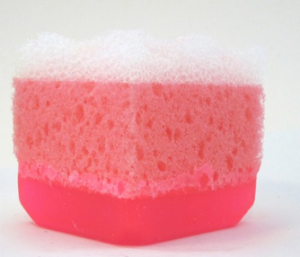October 30, 2019
On 29 April 2012, the following design for “washing sponges, soaps” in Class 28.03 was registered as a Community design in the name of Refan Bulgaria OOD:
The claimant, Aroma Essence Ltd, applied for a declaration of invalidity of the design, claiming that it lacked novelty and individual character, pursuant to Articles 5 and 6 of the Community Designs Regulation (6/2002/EC). It relied on images of two earlier registered designs, which had previously been owned by Refan and which had been declared invalid by the Invalidity Division in October 2012.
The Invalidity Division agreed with Aroma Essence and granted the declaration of invalidity on the basis of one of the earlier designs. It considered that, even if its examination was limited to the facts, evidence and arguments submitted by the parties, nothing prevented it from taking into consideration well known facts. Therefore, it took into account the earlier decisions that had found the two earlier designs invalid.
Refan appealed to the Third Board of Appeal, which annulled the Invalidity Division’s decision. Aroma Essence then appealed to the General Court.
Decision
The GC noted that under Article 63(1) of the Regulation, in proceedings for a declaration of invalidity, EUIPO is restricted to examining the facts, evidence and arguments before it. In addition, Article 52(2) provides that the application for a declaration of invalidity must contain a written reasoned statement, which must contain the grounds of invalidity and an indication of the facts, evidence and arguments submitted in support. Where prior art is cited, the statement must contain a reproduction of the designs relied on, as well as proof of their existence.
In this case, Aroma Essence’s application did not contain any direct and explicit reference to the reasoning, evidence and conclusions of the previous decisions or to the prior designs on which those decisions were based. Aroma Essence had merely stated that Refan’s design should be declared invalid on the same grounds as those relied on in the previous decisions, without explaining what those grounds were or elaborating further on the existence of the prior designs, and attached the previous decisions, which contained screenshots and a catalogue picture, to prove their existence. This was not enough, the GC said, to demonstrate the existence of a prior identical design and to allow EUIPO to assess the lack of novelty and individual character of Refan’s design in relation to those earlier designs. According to case law, the novelty of a design must be assessed in relation to one or more specific, individualised, defined and identified designs from among all the designs that have previously been made available to the public (C-361/15 P and C-405/15 P Easy Sanitary Solutions v Group Nivelles, EU:C:2017:720).
Given that EUIPO can rely only on the facts, evidence and arguments before it, the BoA had been correct in its findings. If Aroma Essence had wanted the BoA to consider not only the designs referred to in the previous decisions, but also the evidence examined in those previous decisions, it should have expressly said so in its application. It should also have expressly referred to and summarised the relevant passages and evidence from those decisions. Merely mentioning the two earlier designs the subject of the decisions and attaching the decisions to the application was not enough. The appeal was dismissed. (Case T-532/18 Aroma Essence Ltd v EUIPO EU:T:2019:609 (17 September 2019) — to read the judgment in full, click here).
Expertise
Topics
